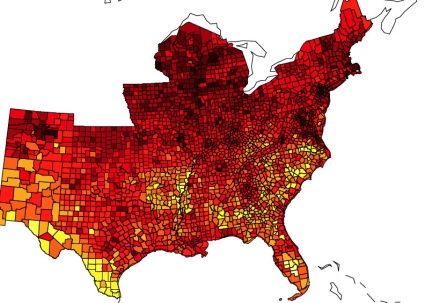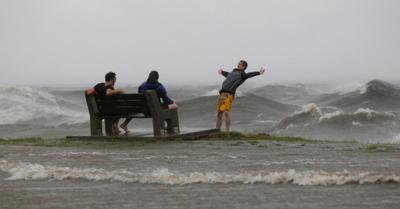The inland dangers of hurricanes, the ugly side of charity, the art of the family video, Smokey the Liar, and the entertainers who strike out at Wrigley Field.
Hurricane Isaac has made landfall in Louisiana and so far levees seem to be holding. The worst of the hurricane is in Plaquemines Parish, right on the water, where water is overtopping levees and flooding some homes. The Parish has water on three sides of it.
NPR is reporting one official’s claim there that the storm is “worse than Katrina.” That may partly because his own home was damaged, but there’s nothing to indicate the storm overall is “worse than Katrina.”
The storm is moving slowly so New Orleans will be in the news for at least another day. Once it moves inland, reporters can leave the beaches and streets and go home. The story is over. There’s nothing more to see here.
But, when you stop to think about it, this map makes a great deal of sense. The lighter shades show the location of damage and/or fatalities during hurricanes. It mostly shows that the greatest threat is inland. Lighter counties are the most affected.

The University Corporation for Atmospheric Research, based in Boulder, Colo., released research yesterday showing 60-percent of fatalities during hurricanes occur inland.
According to LiveScience.com…
Poor areas may not be able to deal well with an emergency, for example, if people don’t have cars or the resources to quickly vacate their homes, said James Done, a UCAR researcher involved in making the map. Both the elderly and very young are also more vulnerable. These groups were among the most affected by Hurricane Katrina, as they were the least able to evacuate the city after the mandatory order came the day before the monster storm struck.
One of the most vulnerable states, according to the analysis, is Arkansas. That’s primarily because the state isn’t well-equipped to respond to disasters or to communicate to its citizens what they should do in case of an emergency, Done said. Isaac’s projected path is likely to take it over Arkansas, where it could dump substantial amounts of rain.
Another strange result is that areas with more men may be more vulnerable; for unclear reasons, 71 percent of hurricane-related flooding victims are male, according to the release.
You can find coverage on New Orleans’ public radio station – WWNO — here.
Last year, Hurricane Irene struck the northeast, doing most of its damage where the TV cameras weren’t — Vermont. Today, the Christian Science Monitor follows up on the lessons learned. “The best preparation is a well-stocked store of community spirit – or a deep reservoir of ‘love thy neighbor’ attitudes,'” it says.
It’s a fairly kneejerk reaction that when tragedy strikes individuals in the country, there’s a quick rush to raise money for the survivors. People contribute with all of the best intentions because it’s the only real way they know to express sympathy for people they don’t know.
But, today, the Chicago Sun Times is revealing the truly ugly side of this practice, focusing on the mass shooting of people earlier this summer at a movie theater in Aurora, Colorado.
About $5 million has been raised for the families of 12 people killed, and very little of it is getting to the families. Instead, non-profit organizations have skimmed the money for their own services.
3) THE ART OF THE FAMILY VIDEO
As we discussed in this space earlier this week, the bathtime videos of children harken back to a simpler time best left in the past. What other options do we have to document the daily lives of our kids?
How about breaking plates? The New York Times’ Lens blog today looks at the art of Mary Magsamen and Stephan Hillerbrand, who document their kids in a different way, one that probably won’t get them in much trouble.
The purpose of the last half of your life is to learn that everything you learned in the first half of your life isn’t true.
Has anyone ever sung Take Me Out to the Ballgame at Wrigley Field without coming off badly? “I don’t care if you never come back”? Oh, Buddy Guy. That’d make a great blues song, though.
More music: NPR is giving readers a free listen of Duquesne Whistle, from Bob Dylan’s new album, scheduled to be released on Sept. 11.
Bonus I: Why isn’t this story getting more attention from the U.S. media? According to the BBC, a group of American soldiers formed an anarchist militia, plotted to overthrow the United States government, and planned to assasinate the president.
Bonus II: Good analysis (as usual) from Nate Silver today, showing how Mitt Romney can help Republicans gain control of the U.S. Senate.
Bonus III: Dogs catching Frisbees. Beat that, Iowa!
Bonus IV: This tweet this morning from Rep. John Kriesel reveals a truth. Minnesota is never going to “get” the zipper merge. Or any other rational kind of merging.
Had a member of the “merging police” try to block both lanes at a zipper merge because he didn’t want me to pass him. Idiot.
— John Kriesel (@johnkriesel) August 29, 2012
Merging properly in Minnesota — with the zipper merge — isn’t worth the grief one takes from other drivers.
TODAY’S QUESTION
Both the Minnesota Orchestra and the St. Paul Chamber Orchestra are facing large deficits, and both are in the middle of difficult contract talks with their musicians. Today’s Question: Can the Twin Cities support two professional orchestras?
WHAT WE’RE DOING
Daily Circuit (9-12 p.m.) – First hour: How the GOP can attract Latino voters, and what Latino voters want to hear from both parties on immigration policy.
Second hour: Millennials — the cheapest generation?
Third hour: The farm bill.
MPR News Presents (12-1 pm): MPR political editor Mike Mulcahy hosts a 5th District congressional debate featuring Democratic congressman Keith Ellison and his Republican challenger Chris Fields.
Talk of the Nation (1-2 p.m.) – The Political Junkie from the GOP convention in Tampa.
All Things Considered (3-6:30 p.m.) – TBA

